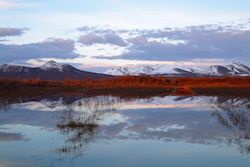A better understanding of the high levels of mercury pollution in the Arctic tundra
If you had to pick a region of the Earth that might be sheltered from human-induced pollution, the Arctic tundra, a vast northern ecosystem surrounding the Arctic Ocean, would be a good start. Yet the area is contaminated with the highly toxic metal mercury known to leak from the soil into rivers and ultimately the Arctic Ocean, contaminating the aquatic life that native communities rely on for survival. Understanding the mercury cycle Industrialised and developing nations emit about 2 000 tonnes of mercury into the atmosphere annually. These mercury emissions come in various forms, such as oxidized mercury, known as Hg(II) and gaseous elemental mercury, or Hg(0). The former tends to remain close to the emission source, while the latter can travel worldwide. Scientists studying the phenomenon, with contributions from the EU-funded project MEROXRE, writing last year in the journal ‘Nature’ outlined how they gathering data year-round, using a lab set up on the tundra. By measuring mercury levels and conducting chemical analyses, the researchers were able to ascertain that Hg(0) represented 70 % of the mercury found in the tundra soil, with Hg(II) less than a third. Given Hg(0)’s ability to travel widely, scientists have been perplexed as to why there should be high concentrations in the Arctic. Professor Daniel Obrist, one of the authors of the study, writing in ‘The Conversation’ notes that Hg(0) in places sunnier and warmer, tend to induce chemical reactions resulting in the Hg(0) being repelled. The researchers suggest that much of the mercury is absorbed from the atmosphere in the leaves of the tundra vegetation, much like carbon dioxide, during the small window of plant growth when snow melts. Given that the plant is then again covered by snow and ice for many months the mercury is sequestered in the soil, protected from the sunlight and heat that might cause the chemical reactions resulting in it becoming airborne again. When the plants shed leaves or die, the mercury is then deposited directly into the soil, which explains why runoff from tundra soil to the Arctic Ocean accounts for half to two-thirds of total Arctic Ocean mercury deposits. In the ocean, the mercury can be converted to organic methylmercury, which is highly toxic and can pass into the aquatic food chain. The EU-funded MEROXRE project’s unique contribution was to measure stable mercury isotopes, a technique which allowed the team to identify various sources of mercury in the atmosphere, snowpack, vegetation and soils. These measurements further confirmed the dominance of Hg(0), suggesting the Arctic tundra as a possible globally significant mercury sink. The team’s findings have largely overturned theories that mercury pollution was due to rain and snow or sea-salt-induced chemical cycling of mercury in the Arctic tundra. Avoiding climate change triggers High levels of mercury in the Arctic have been found in beluga whales, polar bears, seals, fish, eagles and other birds. This impacts on people, especially the local Inuit who get their food from traditional hunting and fishing practices. It is known that extended periods of exposure to high levels of mercury can result in neurological and cardiovascular problems. While studying the potential impacts of climate change was beyond the scope of the project, the researchers point out that global warming could result in the release of sequestered mercury, currently trapped in the permafrost, discharging even more into Arctic waters. Prof. Obrist points out that there is more work to be done to develop a better understanding of plants and soil uptake of Hg(0), and the environmental impact, to help regulators, policy makers and initiatives such as the Minamata Convention, reduce risks. For more information, please see: CORDIS project page
Countries
France



